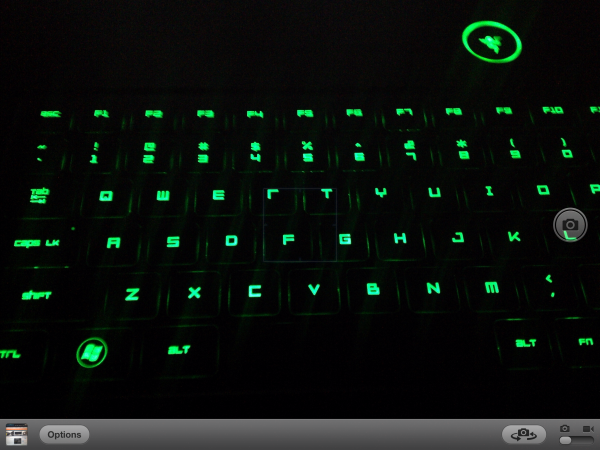The Apple iPad Review (2012)
by Vivek Gowri & Anand Lal Shimpi on March 28, 2012 3:14 PM ESTThe Camera, It's Much Improved
by Vivek Gowri
iOS 5.1 brought with it a number of bugfixes along with a few minor changes to the core entertainment applications (Music, Photos, Videos), but the only real UI change it brought was the redesigned camera application for the iPad. It fixes our biggest complaint with the original—the shutter button’s location in the middle of the settings bar at the bottom of the screen—and ends up being a big improvement from a usability standpoint. The shutter now resides in a floating circular button on the right side of the display, right where your right thumb falls when holding the iPad with two hands. It’s a more intuitive location for the shutter, so taking a picture is a far more natural feeling exercise than it was before. Other than that, the app looks pretty similar—the settings bar now has the still/video slider, front/rear camera switch, an options button, and the link to the photo gallery.
In terms of camera options, there’s only one. You can either have the rule of thirds grid overlay visible or hidden....and that’s it. There’s no other settings for you to change. No exposure, white balance, ISO, shutter speed, or anything else that isn’t the shutter button. Unfortunately, even the HDR mode from the 4 and 4S is nowhere to be found on the iPad. You literally just point and shoot. That’s all there is for you to do.
In our review of the iPad 2, we summed up the cameras with just one word, mediocre. Looking back, I realize now that the word mediocre is a pretty charitable way to describe the iPad 2’s camera situation. Both sensors were borrowed from the iPod touch, and while the VGA front facing camera was acceptable, the rear facing 720p camera was legitimately bad by the standards of a $499 device.
The new iPad fixes that rear camera problem in a big way, with the five element f/2.4 lens and optics borrowed from the iPhone 4S paired with the Omnivision OV5650 CMOS image sensor from the iPhone 4. A quick refresher on specs: 5 megapixels, backside illuminated, 1080p video at 60fps. If you ignore megapixel count, it’s a pretty competitive camera on paper. There’s a lot of recycled parts here, with bits and pieces from other iDevices frankensteined together to come up with a new imaging system for the iPad, but parts-bin raids aren’t bad when the bins being raided from contain top-tier components. The result ends up being pretty good—as a camera, the new iPad is light years ahead of its predecessor in basically every way.
In practice, it’s nothing short of stellar. Image quality is comparable to most high end smartphones, though not quite good enough to be on par with the bleeding edge cameraphones (4S, Nokia N8/N9, HTC Amaze 4G, Galaxy S 2, etc). Interestingly enough, the preview image looks to be running below 30 fps, appearing a little bit choppy at times. This is likely due to the high resolution of the preview and upscaling it to a very high display resolution, but it doesn’t particularly affect image capture. I measured shot to shot time at exactly one second (I had a range between 0.98 and 1.04 seconds, averaged out to 1.0 when factoring in reaction time). That’s about double what Apple claimed for the 4S, and a bit longer than the iPad 2. Granted, the iPad 2’s camera was very quick in part because the amount of processing it takes to capture a 960x720 image is almost zero, with about 13.8% as many pixels as each 2592x1936 image captured by the new iPad.
The focal length is 4.28mm, a bit longer than the iPad 2’s 3.85mm. The difference is actually noticeable; when taking pictures of nearby subjects, you’re sometimes surprised by how magnified the subject appears. However, the camera is good for landscapes, as you can see from the sample gallery. I took the iPad with me on a weekend trip to Victoria, B.C. and used it as my primary camera on the trip. Now, while I wouldn’t trade my SLR for an iPad anytime soon, I can’t deny that the results turned out pretty well. Colours were vibrant, white balance was accurate, and the clouds were nicely highlighted. It’s a quantum leap from the noisy, 0.7MP mess that was the iPad 2 camera. Mouse over the links below to see some comparisons between the cameras on the iPad 2, 3rd gen iPad and TF Prime.

| Apple iPad 2 | Apple iPad (3rd gen) | ASUS TF Prime |
| original | original | original |

| Apple iPad 2 | Apple iPad (3rd gen) | ASUS TF Prime |
| original | original | original |
The new sensor can record 1080p video, up from 720p. Video quality was probably the best aspect of the iPad 2 camera, and it's even better here. Output is recorded at 29.970 fps and encoded in h.264 Baseline with a bitrate of 21Mbps and single channel audio at 64kbps. The recorded video impresses, with crisp detailing and adequate audio quality from the single mic.
The front facing camera keeps the Omnivision OV297AA sensor from the iPad 2, and as such, image and video quality remain unchanged. It’s not necessarily a bad thing, since it remains adequate for FaceTime and Skype, but it would have been nice to see an update to an HD-quality webcam up front.
With augmented reality apps, I’m starting to see the benefit of rear cameras on tablets. For example, the Yelp app, which takes location and compass data to display what restaurants are the direction the iPad is pointing, with a real-time street view of the search results. It’s not necessarily the most useful way to use the rear facing camera in an AR application, but overall it’s an idea that has potential. Apple also tells us that its business and education customers see usefulness in the iPad's rear facing camera as they can use it to quickly document something while using the iPad as a productivity tool. As a consumer, you’re going to get weird looks if you’re using the iPad to take pictures though, it’s a relatively comical sight.
And that’s really the problem: from an ergonomic standpoint, smartphones are just so much easier and more comfortable to use as cameras. And because the imaging hardware is so similar, I’m not sure I see the real benefit of having a rear facing camera on a tablet except in very specific use cases.

























234 Comments
View All Comments
PeteH - Tuesday, April 3, 2012 - link
I have to be honest, after reading through that link I didn't see anything that even implied working conditions had anything to do with the suicides of the factory workers. The only suicide for which there was any real information provided was that of the worker who killed himself after losing the iPhone prototype, and in that case the victim wasn't a factory worker, but someone in logistics.Did working conditions have anything to do with the factory worker suicides? Maybe, maybe not. There doesn't appear to be evidence either way.
mr_ripley - Wednesday, April 4, 2012 - link
I posted the Wikipedia link for all the links in the reference section.Here's a more direct report: http://sacom.hk/wp-content/uploads/2010/11/report-...
And a companion video: http://vimeo.com/17558439
The video includes an interview of a survivor who is now paralyzed waist down.
You can choose to patiently read and watch this report or just turn a blind eye like a lot of people do.
PeteH - Thursday, April 5, 2012 - link
I did read the report. It details unbelievably miserable working conditions in the factories, which I don't think anyone is disputing, and concludes that the way to change those conditions is to pressure the electronics companies making the bulk of the profits. None of the above comments dispute any of this. However it does not link working conditions to suicides among factory workers.And yet you continue to insist that there is a link, with no evidence to back it up. You make statements like, "over a hundred of them have committed suicide over the working conditions," "...scores of people killing themselves citing poor working conditions," and "there is no disputing the fact that these deaths are related to working conditions," but you provide only conjecture to back it up, no proof. When you do this people start dismissing everything you say out of hand, even the things that are accurate. And worse than that, you run the risk that other people arguing for better working conditions will be tarred with the same brush. Look at what happened to Mike Daisy.
Again, I'm not saying working conditions didn't contribute to the suicides, I'm saying there is no evidence one way or the other. Until you have evidence (in the form of suicide notes, higher suicide rates among factory workers, etc.) please stop. You may actually be hurting the very movement you're trying to help.
mr_ripley - Thursday, April 5, 2012 - link
Well, I'm sorry if it is inconvenient for you that these individuals have not said it in so many words. Should we expect them to?... Hey, by the way, I know you're going to kill yourself but why don't your write down an explanation first so we can conclusivly say what the reasons are. And even though you are under a lot of stress right now and are clearly not thinking straight SPELL it our for me please...Evidence can come in different forms. Not all of it is directly incriminating, in which case the attention turns to the circumstances. So if these reports don't establish a reasonbly clear coorelation to you, then I am sorry but I disagree.
You can nitpick on specific words in my comments and quible about words such as evidence. But what are you accomplishing here? Are you justifying your own guilt of purchasing a device manufactured here? Are you an Apple or Foxconn mouthpeice? Do they pay your for spreading lies like Foxconn factories are actually a good place to work (which has been said in the previous comments)? Really, it is people like you need to STOP.
I'm not going to stop saying what I believe is right!! And unlike Mike Daisy I have not fabricated any evidence. At the most, you can complain that I have drawn incorrect conclusions and I am saying the same about you.
PeteH - Thursday, April 5, 2012 - link
It's inconvenient for me that you are lying. You're the one saying that there are, "...scores of people killing themselves citing poor working conditions," not me. Either show me a case where those people who killed themselves cited poor working conditions as the reason, or cease claiming it is fact. You do damage to the movement that's trying to improve things.People hear the news reports about Mike Daisy lying to Ira Glass and what they take away is not the specific lies (claiming to witness things had actually happened but that he had only read about), it's that he's a liar and the story wasn't true. They dismiss the whole issue of poor working conditions out of hand. That's what you risk when you lie to get people to listen.
mr_ripley - Thursday, April 5, 2012 - link
Go ahead, nitpick on specific phrases and completely lose the meaning. But the problem is easily corrected. One can argue that citing something does not have to be done on paper as you would in a professional article. To me the workers "cite" the existence of a problem through their actions as words have failed them.Still if you want me to rephrase I'll say "scores of people killing themselves in midst of poor working conditions.." Can you prove that this statement is inaccurate??
And while you ask me for evidence have you ever bothered to see if you can find evidence that these deaths are not related to working conditions. Prove it to me and I'll take back everything I said.
PeteH - Thursday, April 5, 2012 - link
I think you missed the places above where I stated, "I'm not saying working conditions didn't contribute to the suicides, I'm saying there is no evidence one way or the other." That was my whole point. And I did explicitly state that there's no disputing the poor working conditions. So no, I have no problem with your revised statement.However, I don't think what I did was nitpicking at all. Nitpicking would be pointing out that a score is 20, so scores would imply at least 40, and I've only seen documentation of 17 suicides (I haven't seen numbers pre-2010). But that's not what I did.
shompa - Friday, March 30, 2012 - link
Manufacturing employees?Look at the world! There are about 20 countries in the world that are democratic and have great living standards. Its just 100 years ago since these countries had child workers and harsh condition.
BTW. My county is on the "top countries" in the world. Still we have the largest suicide rate in our population in the world. Why are you not fighting against the Swedish government that drives thousands to kill them self each year? We live like slaves here with 80% taxes.
BTW. Do you care if other companies use HonHai/FoxConn or is it just Apple? Are you writing the same thing about Dell/HP and all other companies that use FoxConn?
What have you done?
Have you donated money to a chinese worker? Or is Trolling the only thing you manage to do?
grave00 - Friday, March 30, 2012 - link
I was curious about this statement. Could you elaborate. What inconsistency is there?"On the iPhone Apple has been entirely too lax about maintaining consistency between suppliers. If it wants to be taken seriously in this space Apple needs to ensure a consistent experience across all of its component vendors."
loboracing - Friday, March 30, 2012 - link
I remember an ad that touted something new to "see and touch". The retina screen is the "see" part but what about the "touch"? Was that just a gimmick meaning you could touch the screen, or is there some sort of different feel to the screen?